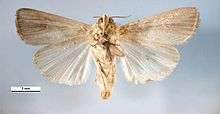Leucania loreyi
| Leucania loreyi | |
|---|---|
 | |
| Dorsal view | |
 | |
| Ventral view | |
| Scientific classification | |
| Kingdom: | Animalia |
| Phylum: | Arthropoda |
| Class: | Insecta |
| Order: | Lepidoptera |
| Family: | Noctuidae |
| Genus: | Leucania |
| Species: | L. loreyi |
| Binomial name | |
| Leucania loreyi (Duponchel, 1827) | |
| Synonyms | |
| |
The Cosmopolitan (Leucania loreyi) is a species of moth of the Noctuidae family. It is found in most of Africa, the Indo-Australian subtropics and tropics, the eastern Palearctic ecozone and the Near East and Middle East.
- See glossary for terms used
Forewing greyish ochreous; the veins pale lined with brown, the intervals with brown lines; a short black streak from base below cell; median nervure thickly outlined with fuscous to beyond cell; reniform stigma indicated by a white dot at lower angle of cell; outer line by a row of black dots on veins; a triangular brown subapical patch edged above by an oblique pale streak from apex; hindwing white, the veins towards termen fuscous; abdominal tufts beneath formed of coarse scalelike brown black hairs. A tropical species, an occasional visitant only in Britain, and in Europe mainly occurring in the South; Spain, Portugal, Italy, France, Switzerland, Austria; Egypt, Morocco, the Canaries, and Madeira; Asia Minor, Armenia, Syria, Japan.[1]
Biology
Adults are on wing year round. There are multiple generation per year.
Larva reddish grey, yellowish between the segments; dorsal line fine, grey, double; subdorsal lines divided, interrupted, all clearer towards the anal segments; spiracles ringed with black.
Recorded food plants in Israel include Phragmites australis, Sacharum ravennae and Gramineae species. Occasionally they are found on ornamental bamboo and once in an experimental rice field, a pest of winter cereals (wheat, barley) and summer cereals (corn, sorghum, sugar cane). Other recorded food plant include various grasses, such as Oryza, Paspalum, Saccharum, Triticum and Zea species.[2]
References
- ↑ Seitz, A. Ed., 1914 Die Großschmetterlinge der Erde, Verlag Alfred Kernen, Stuttgart Band 3: Abt. 1, Die Großschmetterlinge des palaearktischen Faunengebietes, Die palaearktischen eulenartigen Nachtfalter, 1914
- ↑ "Robinson, G. S., P. R. Ackery, I. J. Kitching, G. W. Beccaloni & L. M. Hernández, 2010. HOSTS - A Database of the World's Lepidopteran Hostplants. Natural History Museum, London.".
External links
| Wikimedia Commons has media related to Leucania loreyi. |
- Lepiforum
- Funet Taxonomy
- Fauna Europaea
- Hadeninae of Israel